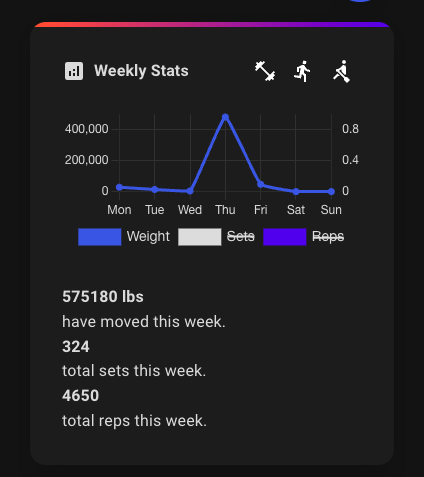The debate between lifting heavy weights for low repetitions versus lighter weights for high repetitions has been longstanding in the fitness community. However, research indicates that when exercises are performed to muscle failure, both approaches yield similar results in terms of muscle hypertrophy. This underscores the importance of training volume as a key metric in resistance training.
Understanding Training Volume
Training volume is a quantifiable measure of the total work performed during a workout session. It is commonly calculated using the formula:
Volume = Sets × Repetitions × Weight
For example:
If an individual performs 3 sets of 10 repetitions with 50 lbs, the total training volume would be:
3 sets × 10 reps × 50 lb = 1,500 lb
This metric provides a comprehensive view of the workload and helps in structuring training programs effectively.
Why I Focus on Volume in WeightLiftr
In my own training and in the design of WeightLiftr, I’ve chosen to focus on tracking volume because it’s a clear, objective measure of work done—regardless of whether the user prefers lifting heavy or doing higher reps with lighter weight. It cuts through the noise of training styles and gives every athlete, from beginners to advanced lifters, a common ground for measuring progress.
By logging volume over time, WeightLiftr helps users visualize their workload trends, avoid plateaus, and make smarter adjustments based on real data. It doesn’t just track numbers—it tells the story of your consistency and effort.
How I Plan to Expand on the Idea
In future updates to WeightLiftr, I plan to build features that go beyond raw volume:
- Volume over time graphs to show weekly and monthly workload trends.
- Per muscle group tracking, helping users spot imbalances or undertrained areas.
- Fatigue and recovery insights, using volume spikes and drops to flag potential overtraining or the need for a deload.
- Smart suggestions that recommend when to increase sets, reps, or weight based on previous volume history.
Ultimately, my goal is to make volume not just a stat, but a tool for smarter training. By grounding progress in evidence-based metrics, WeightLiftr can help users train more intentionally and sustainably.

In conclusion, while both heavy and light load training can be effective for muscle growth, focusing on training volume offers a comprehensive and adaptable framework for designing effective resistance training programs.
Supporting Studies
-
A study by Schoenfeld et al. compared low-load (25–35 reps per set) and high-load (8–12 reps per set) resistance training over eight weeks in well-trained men. Both groups experienced significant increases in muscle thickness across various muscle groups, with no notable differences between them.
📚 PubMed Study -
Another study examined the effects of different loading schemes on muscle adaptations. The findings suggested that muscle hypertrophy can be achieved across a wide spectrum of loading ranges, provided the exercises are performed to muscle failure.
📚 PMC ArticleWhy Volume is a Good Metric
-
Muscle Hypertrophy: There is a positive relationship between training volume and muscle growth. Increasing volume—up to an individual’s capacity to recover—can lead to greater hypertrophy.
🔗 Wikipedia - Strength Training -
Progressive Overload: Monitoring volume allows for systematic increases in workload, facilitating continuous adaptation and progress.
🔗 Wikipedia - Progressive Overload -
Individualization: Volume can be adjusted based on individual goals, recovery ability, and training experience, making it a versatile tool in program design.
Reputable Sources Supporting Training Volume
-
Stronger by Science: Emphasizes considering the total number of challenging sets per muscle group as a practical approach to measuring training volume, highlighting its significance in promoting muscle growth.
🔗 The New Approach to Training Volume -
Juggernaut Training Systems: Discusses the critical role of volume in training, noting that it must be increased over an athlete’s career to continue making progress, while also cautioning against excessive volume leading to overtraining.
🔗 Understanding Volume - JTS Strength -
Wikipedia - Strength Training: Highlights that training volume is one of the most critical variables in the effectiveness of strength training, with a positive relationship between volume and hypertrophy.
🔗 Wikipedia - Strength Training